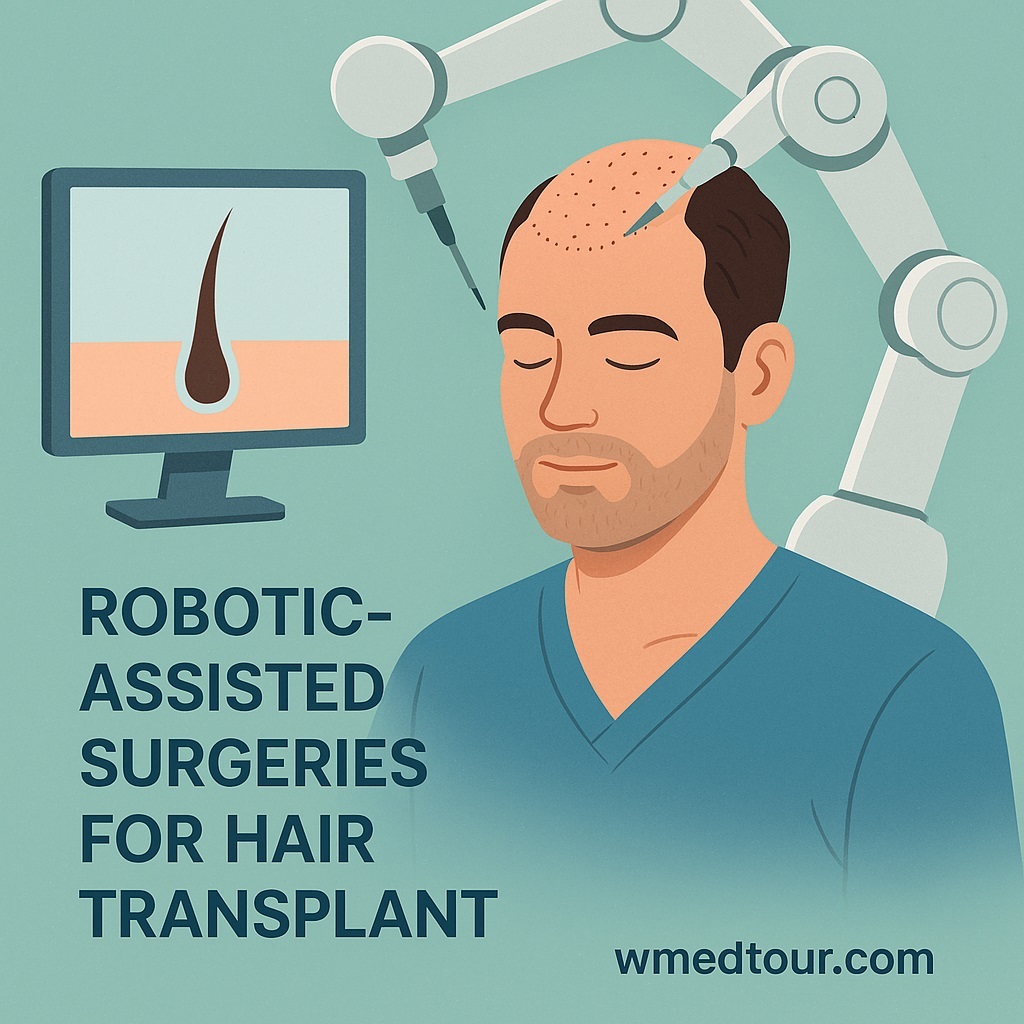Robotic Hair Transplant (ARTAS FUE) | Fast, Natural Results for All Individuals
The definitive guide to the world’s most precise hair restoration technology, covering advanced protocols and unique advantages for female hair loss.
Executive Summary: Key Takeaways
- The Core Technology: The Robotic Hair Transplant (ARTAS FUE) system utilizes a highly precise robotic arm, 3D digital mapping, and AI algorithms to select, extract, and site-create follicular units. This removes the variable of human fatigue.
- Precision and Consistency: The robotic system achieves unparalleled consistency, resulting in a transection rate (graft damage) typically below 5%, which is often superior to even the most skilled manual methods.
- Crucial for Women: ARTAS offers specialized “No-Shave” or “Minimal-Shave” FUE protocols. This is a game-changer for women, as it allows for discrete procedures without the need for total shaving, significantly shortening the social recovery time.
- Natural Results: The robot digitally plans the depth, angle, and orientation of every transplanted graft, ensuring the new hair growth perfectly mimics the surrounding natural hair, resulting in an undetectable, natural-looking hairline.
- Global Access: The technology is considered premium, but global hubs, particularly in Turkey and the UAE, offer competitive pricing without compromising quality. You can explore options on our Best Countries for Hair Transplant Guide.
1. The Science of Robotic Hair Transplant (ARTAS FUE): Precision Meets Artistry
The evolution of hair restoration has been marked by a constant pursuit of precision. Follicular Unit Extraction (FUE) revolutionized the field by eliminating the linear scar of the old FUT method. The next great leap is the application of robotics. The Robotic Hair Transplant (ARTAS FUE) system represents the gold standard in automated FUE technology, melding a surgeon’s artistic vision with the consistency of a machine.
The ARTAS system utilizes advanced digital imaging and algorithmic software. This technology meticulously maps the patient’s scalp in three dimensions. Why is this critical? The human eye cannot accurately assess the exact angle and depth of thousands of individual hair follicles beneath the skin. The robot, however, can identify and target the best follicular units with sub-millimeter accuracy. This process significantly reduces the risk of damaging neighboring hair, known as the transection rate. Experts consider a low transection rate to be the primary indicator of a successful FUE procedure. You can read more about various techniques in our guide on FUT vs. FUE vs. DHI.
1.1. The Three Core Mechanisms of ARTAS
- Digital Mapping & Selection: The system scans the donor area (usually the back of the head). It uses advanced optics to analyze the density, angle, and grouping of follicular units. Furthermore, its proprietary algorithms select only the healthiest grafts, maximizing the yield of viable transplantable hair.
- Robotic Extraction: A multi-faceted robotic arm is guided by the digital map. It employs a double-punch mechanism to precisely dissect and extract the chosen follicular unit without damaging adjacent hairs. This consistency is impossible to maintain manually over thousands of grafts.
- Recipient Site Creation: This is where the artistry is digitized. The surgeon first maps the desired hairline. Then, the robot executes the creation of thousands of tiny recipient sites with precise control over depth, angle, and direction. This robotic control is crucial for ensuring the new hair blends seamlessly with the existing hair structure. For instance, the angle on the sides of the head must be acute, while the top requires different geometry.
The consistent placement and harvesting protocols dramatically reduce the trauma to the grafts and the surrounding tissue. Consequently, patients experience faster healing and more reliable growth rates, which is a major advantage for all individuals seeking quick recovery. You can review the terminology in our Hair Transplant Glossary.
2. A Game-Changer: Robotic Hair Transplant for Women
While hair transplantation is sought by individuals of all genders, the procedure is increasingly sought by women dealing with pattern hair loss, trauma-related scars, or genetic thinning. The Robotic Hair Transplant (ARTAS FUE) offers specific, highly relevant benefits for female patients.
2.1. Addressing the Core Female Concern: No-Shave FUE
The biggest hurdle for many women considering FUE is the requirement to shave the entire head. This necessitates a long ‘social recovery’ period. The ARTAS system, particularly with newer models and protocols, addresses this directly. It allows for a minimally-invasive technique known as ‘Non-Shaven’ or ‘Partial-Shave’ FUE.
In this approach, only small, hidden strips within the donor area are clipped. The surrounding longer hair acts as a curtain, completely concealing the procedure site. Therefore, a female patient can undergo the transplant and often return to work or social settings much faster than with traditional FUE. This discreet recovery is invaluable and shifts the suitability criteria for many women. Moreover, the robotic precision ensures the selective harvesting does not create noticeable gaps in the donor area, a critical aesthetic detail.
2.2. Precision in the Recipient Area (Hairline and Temples)
The female hairline and temple areas require exceptional artistry and precision. The ARTAS robotic system excels here. Since the robot controls the angle and direction of the needle creating the recipient channel, the surgeon can achieve a softer, more feathered look, which is essential for a natural feminine hairline. A study published by the International Society of Hair Restoration Surgery (ISHRS) noted that robotic site creation provided superior angular consistency when treating female temple recession.
Pros and Cons of Robotic FUE for Women
⭐ Pros
- Aesthetic Discretion: Minimal or No-Shave protocol is possible.
- Faster Healing: Consistent, smaller punch sizes lead to quicker donor area recovery.
- Superior Graft Quality: Low transection rate ensures more viable grafts.
- Natural Look: Robotic site creation guarantees optimal angle and direction.
- Reduced Surgeon Fatigue: Consistent high quality throughout long procedures.
⚠️ Cons
- Higher Cost: Generally the most expensive FUE method globally. See our guide on FUE Hair Transplant Global Cost.
- Limited Donor Pool: The robot can only harvest from certain regions of the scalp.
- Not for All Hair Types: Extremely fine or light-colored hair can occasionally pose minor challenges for the robotic sensor.
3. Robotic Hair Transplant vs. Traditional Methods
Understanding how the Robotic Hair Transplant (ARTAS FUE) compares to its predecessors is essential for making an informed decision. While all FUE methods are less invasive than FUT, the ARTAS system offers undeniable advantages in consistency and technology.
3.1. Detailed Comparison Table
| Feature | Robotic FUE (ARTAS) | Manual FUE (Traditional) | FUT (Strip Method) |
|---|---|---|---|
| Extraction Method | Automated robotic arm using digital mapping. | Surgeon uses handheld punch tool. | Scalpel removes a strip of skin. |
| Scarring | Virtually undetectable micro-scars. | Micro-scars (less uniform). | Permanent linear scar. |
| Precision & Graft Viability | Highest (AI-driven, low transection rate). | Good (depends on surgeon’s skill/fatigue). | Very High (dissection under microscope). |
| Procedure Time (Large Session) | 4-8 Hours (Fast extraction). | 6-10 Hours (Slower extraction). | 4-6 Hours. |
| Cost | Premium (Highest). | Mid-Range. | Lowest. |
The table highlights a critical takeaway: while FUT offers a high graft count and Manual FUE offers a lower cost, neither can match the consistent, machine-driven precision of the ARTAS system. This predictability is worth the premium for many individuals, especially those targeting a perfect, natural-looking hairline. Furthermore, the ARTAS system’s consistency drastically reduces the risk of having to seek a second procedure later. This can be a huge cost saving in the long term, preventing unnecessary complications discussed in our Hair Transplant Side Effects Guide.
4. Patient Journey: A Case Study in Robotic Success
To illustrate the real-world impact of the Robotic Hair Transplant (ARTAS FUE), let us consider a hypothetical patient, Sarah, who sought hair restoration for female pattern hair loss.
4.1. Case Study: Sarah, 35, Diffuse Thinning
Sarah was a marketing executive whose primary concern was the thinning across her crown and temples. She had sufficient, stable donor hair but absolutely refused to shave her head due to her professional visibility. Her goal was a subtle increase in density and a restored, soft hairline. She explored several options, including DHI and manual FUE, but ruled them out due to the required shaving and concerns about manual precision over a large, feathered area.
The ARTAS Solution
Sarah chose a leading clinic in Istanbul (you can find top specialists on our Clinics and Doctors in Istanbul page). The surgeon opted for an ARTAS Minimal-Shave FUE protocol, extracting 1,800 grafts primarily from a small, hidden strip at the back of her head, completely concealed by her existing hair. The entire procedure took just under six hours.
Results and Recovery
Day 3: Sarah was able to gently wash her hair. The donor area was invisible. The recipient area showed small scabs, which were easily concealed with her existing longer hair. She could attend video meetings (camera only from the chest up) without issue.
Month 4: The transplanted hair began its anagen phase (growth), and Sarah noted a visible increase in density. The high viability of the ARTAS-extracted grafts contributed to this rapid, uniform result.
Month 12: Sarah achieved her final result—a fully restored crown and a natural, feathered hairline with no detectable change in her donor density. The robotic precision in site creation ensured a completely natural hair flow, undetectable even under close inspection. This outcome confirms the efficacy of modern technology in hair restoration, a trend visible across various specialties like those discussed in our guide to New Methods in Fat Removal Treatment in 2025.
5. Who is This For? The Ideal Candidate Profile
While the Robotic Hair Transplant (ARTAS FUE) system is a superior technology, it is not the ideal solution for every single individual. Determining candidacy requires a thorough evaluation by an expert in hair restoration (Find a Specialist).
5.1. Ideal Candidates
- Patients seeking the most natural results: Those who prioritize undetectable hair direction and angle.
- Individuals requiring minimal shaving: Patients who need a discreet procedure due to professional or social requirements, a key benefit for women and others with longer hair.
- Large Sessions: Patients needing over 2,500 grafts where surgeon fatigue could compromise quality in a manual procedure.
- Patients with specific hair textures: The robotic visualization system is highly effective at managing curlier hair types by accurately mapping the follicle’s path under the skin, reducing damage noted in a Mayo Clinic review (Source Link).
- Individuals prioritizing efficiency: Those who want the fastest, most consistent extraction process.
5.2. Who May Need an Alternative?
- Patients on a strict budget: Given the premium cost, lower-cost options may be more suitable (Hair Transplant Cost Turkey 2025).
- Diffuse Alopecia: Patients whose donor area is too unstable or thin, as the robot still requires sufficient density to harvest.
- Severe Scarring: While possible, certain types of severe scarring in the donor area may prevent the robot’s sensor from functioning optimally.
6. Key Factors Influencing ARTAS FUE Cost and Global Travel
The cost of a Robotic Hair Transplant (ARTAS FUE) is a significant factor in an individual’s decision-making process. Since the technology is proprietary and complex, the operational costs are higher than traditional FUE.
6.1. Breakdown of Cost Variables
Cost typically reflects the following factors:
- Number of Grafts: The price is usually calculated per graft or per session size (e.g., 2,000 grafts).
- Geographic Location: Centers in Western Europe or North America can charge 2x to 4x the rate of centers in medical tourism hubs like Turkey, India, or Iran. Our guide on Global Medical Tourism explains this cost variance.
- Surgeon Expertise: The fee reflects the surgeon’s experience and reputation, as the surgeon remains crucial for planning the hairline and overseeing the procedure. You can check surgeon credentials on our Doctor Directory.
- Facility Accreditation: Procedures performed in accredited, state-of-the-art facilities with the latest ARTAS software will command a higher price.
- Inclusion of No-Shave Protocol: The specialized ‘No-Shave’ technique, often requested by female patients, requires more time and manual work, which can increase the overall price.
For many international patients, traveling to high-quality, low-cost destinations for a Robotic Hair Transplant (ARTAS FUE) is the best way to access this premium technology without the prohibitive price tag. Furthermore, the robust safety standards in these top international clinics are often equivalent to, or surpass, Western standards (Authoritative Health Link). Before booking any travel, review the legal requirements in your destination using our Turkey Regulations Guide or Global Regulations Guide.
7. Looking Ahead: The Future of ARTAS and Automation
The ARTAS system is continually being refined. Its future lies in even greater levels of automation and integration with other diagnostic tools. Current research focuses on combining ARTAS with Artificial Intelligence (AI) to automatically predict long-term hair loss patterns. This would allow the robot to select grafts that are not just currently healthy, but also those most likely to remain permanent over the next 10-20 years (University Research Link).
Furthermore, the ongoing development of regenerative medicine—such as PRP therapy—is becoming increasingly integrated with ARTAS procedures. Many clinics now follow an ARTAS FUE with a PRP injection to accelerate healing and enhance growth, providing a comprehensive solution (Skin and Hair Department). This holistic approach ensures the transplanted hair not only survives but thrives.
8. Frequently Asked Questions (FAQ) About Robotic Hair Transplant
What is the key difference between ARTAS FUE and manual FUE?
The key difference is precision. ARTAS uses a robotic arm and advanced digital mapping to extract grafts with unparalleled consistency and speed. This minimizes human error, fatigue, and maximizes graft survival, a distinct advantage over manual extraction.
Is Robotic Hair Transplant suitable for women with diffuse hair loss?
Yes, but suitability depends on the donor area. ARTAS can be effective for female pattern hair loss if the donor hair is dense and stable. It is often preferred because some advanced ARTAS protocols allow for minimal shaving of the donor area, addressing aesthetic concerns.
Does the ARTAS robot create the recipient sites?
Yes. The ARTAS system uses algorithmic mapping to determine the optimal angle, direction, and density for each recipient site. This robotic precision ensures the new hair grows in a highly natural direction, which is critical for an undetectable result.
How long does the ARTAS FUE procedure take?
The procedure typically takes 4 to 8 hours, depending on the number of grafts required. The robotic precision allows for faster extraction compared to many manual techniques, making it more efficient for large sessions.
What is the recovery time after Robotic Hair Transplant?
Recovery is generally fast. Most patients return to light activities within 1-2 days and resume normal exercise within a week. The tiny extraction sites heal quickly, and the redness in the recipient area usually subsides within 7-10 days.
Is the ARTAS procedure painful?
The procedure is performed under local anesthesia. Patients typically feel little to no pain during the transplant itself. Some mild soreness or discomfort may occur in the donor area afterward, which is easily managed with simple over-the-counter pain medication.
How much does Robotic Hair Transplant (ARTAS FUE) cost globally?
The cost of Robotic Hair Transplant (ARTAS FUE) varies widely by country and the number of grafts. It generally sits at the premium end of the FUE market due to the sophisticated technology involved. Countries like Turkey and the UAE offer highly competitive packages. (Global Cost Analysis)
Are the results of ARTAS FUE permanent?
Yes, the results are permanent. The transplanted hair follicles are typically taken from the ‘donor zone’ at the back of the head. This area is genetically resistant to hair loss, and these follicles retain their resistance even after being moved to the recipient area.
Does ARTAS FUE leave a linear scar?
No. Like all FUE methods, ARTAS extracts individual grafts. This leaves behind tiny, circular micro-scars that are virtually undetectable, even with short hair. This is a key advantage over the older FUT strip method.
Can I have an ARTAS transplant if I have wavy or curly hair?
Yes, ARTAS is highly effective for various hair types. Its advanced digital imaging system maps the angle and curvature of the follicle beneath the skin. This allows the robotic arm to adjust its trajectory, significantly reducing the transection rate (damage) for curly hair. This is a common challenge in manual procedures.
Is ARTAS better for certain genders?
ARTAS is highly effective for all individuals. However, it offers unique benefits for female patients, such as the ability to perform the procedure with minimal shaving of the donor area. For individuals with extensive baldness, its speed and precision are ideal for restoring large areas, particularly in the crown and hairline.
What are the latest advancements in ARTAS FUE technology?
Recent advancements include improved digital planning software, enhanced optics for finer graft selection, and protocols that require little to no shaving of the donor area (known as Long-Hair FUE). This is a massive leap for patients prioritizing discretion and recovery aesthetics. (Restoration Society News)
How do I choose the right surgeon for my ARTAS procedure?
Choosing the right surgeon is crucial. You must select a specialist who is certified and has extensive experience with the ARTAS system. Look for a large portfolio of robotic hair transplant procedures and positive patient reviews. Furthermore, verify the clinic’s credentials on our About Us page and check out our Top Hair Transplant Clinics recommendations.
Conclusion: Investing in Precision and Permanence
The field of hair restoration is continually driven by technological innovation. The Robotic Hair Transplant (ARTAS FUE) system stands out as a superior choice for individuals who prioritize consistency, speed, and the most natural possible aesthetic results. Its unique ability to facilitate minimally-shaved procedures makes it a particularly compelling option for women and others with long hair. By removing human error from the most repetitive steps, ARTAS ensures that the surgeon’s focus remains on the artistic elements: hairline design and aesthetic density. When considering this premium solution, we recommend a thorough consultation with a certified ARTAS physician to tailor a plan specifically for your needs. The final results are a reflection of the precision invested in the procedure. For more information on your options, please consult our Modern Hair Transplant Guide.
Ready to Explore the ARTAS FUE Difference?
Connect with WMedtour’s certified specialists for a detailed, personalized consultation and access to the world’s leading Robotic Hair Transplant (ARTAS FUE) centers.
Internal Resources for Further Reading:
- FUT vs. FUE vs. DHI: Success Rates and Fees
- FUE Hair Transplant Global Cost 2025 Guide
- Global Hair Transplant FAQ Guide 2025
- Hair Transplant Complete Glossary of Terms
- Best Country for Hair Transplant in 2025
- Hair Transplant Cost Turkey 2025
- WMEDTOUR Skin and Hair Department
- About WMEDTOUR Global Hub Portal




